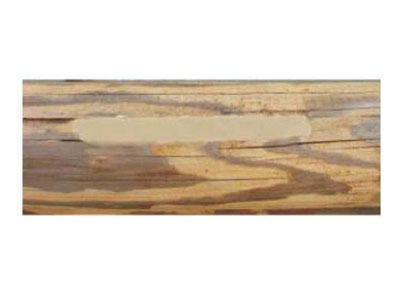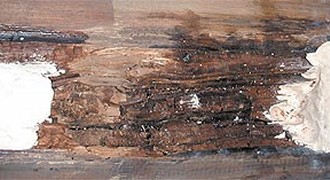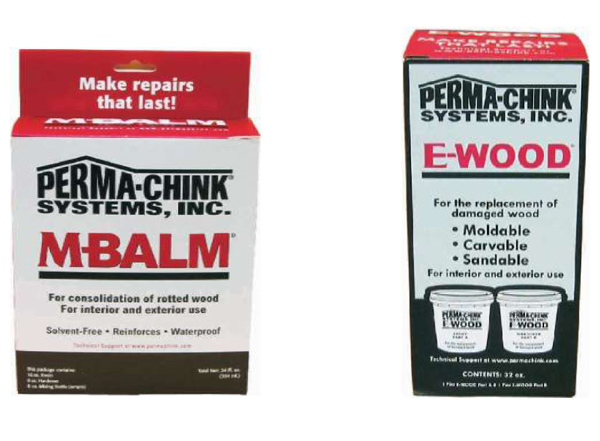M-Balm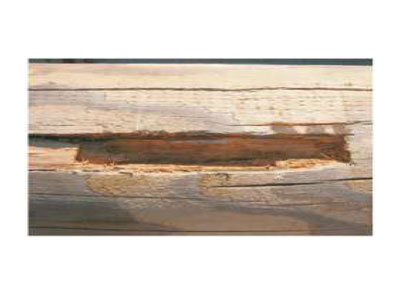
When the A and B components of M-Balm are mixed together, they form a low viscosity liquid. In other words, it is not much thicker than water. The purpose for this low viscosity is to allow the product to soak into wood fibers. After about 15 to 20 minutes, the liquid M-Balm will begin to harden and once hard, any loose, friable wood fibers will be consolidated into a solid mass. One limitation of M-Balm is that the wood must be very dry, 15% moisture content or less, for the M-Balm to be able to soak into the wood. This presents a challenge when attempting to repair areas that have been damaged by decay, since typically these areas are quite damp. The best thing to do in these cases is to remove the source of the moisture by eliminating any leaks or draping a plastic film over the area to prevent rainwater from saturating the wood. You must wait until the wood is dry before attempting to repair it.
Note: When repairing wood that has been damaged by decay fungi, we recommend that the area first be treated with Shell-Guard® RTU to eradicate any decay fungi that may still be alive and to prevent any future infestations from reoccurring. The Shell-Guard RTU solution may be applied while the area is still wet or moist but it is still important that the wood be allowed to dry before applying M-Balm.
The easiest way to apply M-Balm is with some type of plastic squeeze bottle like a clean, empty mustard container. Just be sure to mix the two components together before you pour them into the container. You need to be aware that within a few minutes after being mixed together the liquid gets hot- very hot! The greater the volume, the hotter it will get.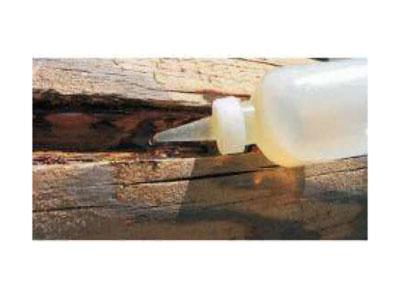
The heat is the result of an exothermic chemical reaction that takes place between the A and B components. It’s best to mix small quantities of M-Balm at a time, not only for this reason but once mixed, M-Balm hardens in just 15 minutes. Any product that’s not applied within that time will end up being unusable. M-Balm can be applied with a brush, but once the M-Balm begins to cure the brush will become hard and will have to be discarded.
Whichever application method you use, try to avoid getting any M-Balm on the surface of the wood. It’s impossible to cover cured M-Balm with a paint or stain, and any spots of M-Balm that get onto the visible surface will always stick out from the rest of the wall. Whenever you are planning to fill a pocket or void using E-Wood, or any other type of wood filler, it’s important to first use M-Balm to consolidate any loose wood fibers present on the inside surfaces of the void. Wood fillers and putties, like E-Wood, will not adhere to loose fibers, and if you don’t consolidate them first with M-Balm, you run the risk that the patch will fall out of the void sometime in the future. It is not necessary to wait until the M-Balm cures before filling the void. Being an epoxy it will cure even in the absence of air.
E-Wood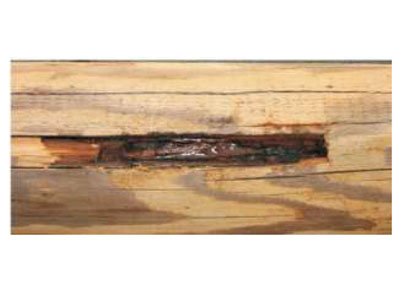
E-Wood is a two-component epoxy putty that can be used to fill holes or voids in wood. E-Wood should not be used to fill checks or gaps between logs since once it cures, it has no flexibility; any movement will cause it to pull away from the wood. E-Wood is somewhat challenging to mix together, since both components are thick and putty-like. Equal amounts of both A and B components must be kneaded together by hand until the color is uniform throughout the mass.
Up to two (2) ounces of Lifeline™ stains can be added to 24 ounces (12 ounces of component A and 12 ounces of component B) of blended E-Wood to aid in the hiding of the repair.
Once it is thoroughly mixed, it can then be pressed into the void and shaped to match the contour of the surface. If desired a texture or pattern may be worked into the surface of the uncured E-Wood to help it blend in with the surrounding wood.
Stain can be applied to the surface of the E-Wood either before or after it has cured. E-Wood will begin to harden in about an hour or two, so you have more time to work with it than you do with M-Balm. Being an epoxy, no shrinkage will occur once the E-Wood is in place.
For additional information about M-Balm and E-Wood see: “M-Balm & E-Wood” and “How to Repair Large Voids” technical tips.
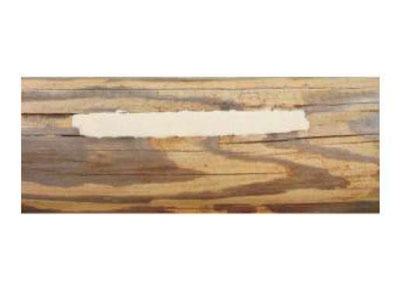
M-Balm & E-Wood Epoxies
Perma-Chink Systems sells two epoxy products, M-Balm®, a wood consolidator that hardens loose, friable wood fibers, and E-Wood®, a putty used to fill voids or cavities in logs and timbers. Both M-Balm and E-Wood are two component epoxies. Like all epoxy products, they consist of a resin and a hardener and rely on a chemical reaction between the two components to become hard. As they react they often become warm, or even hot. M-Balm, in particular, can become quite hot about 15 to 20 minutes after the two components are mixed together.
Tip: Mix M-Balm in a disposable aluminum bread pan. This allows mixed component to release heat (exothermic) and cool while preventing you from melting your mix container or bottle.
There is one thing about epoxies that you should understand: as epoxies age they lose their chemical reactivity. The older they get, the longer it may take for the combined components to become hard. If unused epoxy has been in your garage for a couple of years or more, it’s not unusual for the hardening process to take three or four times longer than when using fresh product. It’s not that it won’t eventually harden, it’s just reacts slower and takes longer.
Never change the ratio of hardener to resin to try and speed things up. Unlike other types of resin and catalyst mixtures, M-Balm MUST be mixed together at a ratio of two parts of Part A to one part of Part B by volume. For E-Wood, equal volumetric parts of Part A and Part B MUST be kneaded together for these products to work.
Tip: Mix only the amount necessary to complete each step of a small job.
Here’s one more tip: M-Balm does NOT have to be cured before applying E-Wood. Epoxies do not “dry” in the sense that they must be in contact with air. They rely on chemical reactions to harden and cure, so M-Balm will harden just as rapidly under E-Wood as it will if left exposed. In fact, applying E-Wood before the M-Balm cures results in an even stronger bond to the wood.
